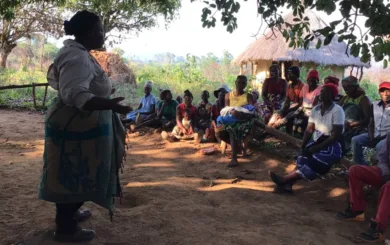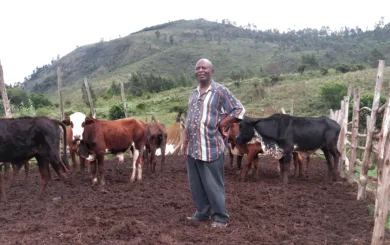Zimbabwe continues to bear the long-lasting impacts of mine contamination stemming from the war of liberation in the 1970s. This contamination poses severe threats to border communities that heavily rely on subsistence farming and grazing. The devastating consequences are evident in the thousands of cattle killed or injured by landmines.
The presence of mines not only disrupts cross-border trade with Mozambique but also hampers the reunification of families and endangers the safety of children commuting to school. Tragically, accidents caused by mines and exploded ordnance persist, with casualties since 1964 estimated to be at least 1,638. The most recent accident occurred on October 12, 2023, in Mudzi District, Mashonaland Central.
As of the beginning of 2024, Zimbabwe still has approximately 15 km2 of mined areas awaiting clearance. As a state party to the Mine Ban Treaty, Zimbabwe has set a revised clearance deadline of 31 December 2025. However, due to the country's economic downturn, Zimbabwe requires increased international funding to meet this crucial deadline.
To address the issue, the National Mine Action Authority of Zimbabwe (NAMAAZ) serves as the policy and regulatory body overseeing all matters related to Mine Action in the country. The Zimbabwe Mine Action Center (ZIMAC) manages the Mine Action program in accordance with the national strategy spanning from 2018 to 2025. NPA is one of the four international non-governmental organizations (NGOs) operating in Zimbabwe, actively contributing to mine clearance efforts, and providing valuable support.
Norwegian People's Aid in Zimbabwe
NPA's mine action program in Zimbabwe has made significant strides since its inception in 2012. By the end of 2023, NPA released 16.8 km2. This achievement resulted in the destruction of 29,156 antipersonnel mines, benefiting 468,120 beneficiaries residing in Mutare, Mutasa and Chipinge District within Manicaland Province, as well as in Mudzi District under Mashonaland East Province.
The survey activities carried out by NPA have played a pivotal role in enhancing the estimation of remaining mine contamination, enabling more efficient allocation of resources. In Zimbabwe, NPA predominantly relies on manual demining teams for clearance operations but has boosted productivity by around 25 % since introducing mine detection dog (MDD) teams in 2018. Looking ahead, NPA will focus on completion of Manicaland by the end of 2024 and continue its activities in Mashonaland East.
The GMAP2 Post-clearance Pilot Household Survey on Livelihoods and Basic Services Indicators, was conducted in the NPA Zimbabwe programme in May 2023.
In 2023 NPA participated in a post-clearance Pilot Household Survey on Livelihoods and Basic Services Indicators aimed to measure the outcomes of mine clearance on the NPA Zimbabwe Programme. The survey collected data on livelihoods and basic services after clearance and was organised by ITAD in support of the UK’s Global Mine Action Programme (GMAP2).
The survey was conducted in Burma Valley and Border Streams. The Burma Valley has been contaminated since 1976. Clearance activities began in 2013 and handed back to the community in 2015. 545,405 m2 was cleared, benefitting 755 people directly and 5,051 people indirectly. 76% of the survey respondents had been exposed to both pre- and post-clearance experiences, indicating the credibility of the findings. Notably, 57% of the respondents reported building new homes after clearance, highlighting increased safety and a transformation of the area for agricultural activities, habitation, tourism, and community development.
The survey also demonstrated positive impacts on community development, including expansion of arable land, improved road networks, enhanced access to information centres, and freedom of movement. The survey findings emphasize the importance of ongoing collaboration to ensure sustainable development in mine-cleared communities, particularly in areas such as water sanitation and irrigation requirements.
NPA also conducts explosive ordnance risk education in its operations, targeting at-risk individuals such as children, women, and men involved in agriculture within confirmed hazardous areas. The goal of these sessions is to reduce the risk of injury from explosive ordnance by raising awareness and promoting behavioural change among affected communities.
NPA has made significant contributions to Zimbabwe's efforts in addressing mine contamination and its associated challenges. By clearing vast areas, directly benefiting hundreds of thousands of individuals within Mutare, Mutasa and Chipinge Districts under Manicaland Province and Mudzi District under Mashonaland District and promoting risk education, NPA’s Zimbabwe programme plays a crucial role in reducing poverty, increasing food security, and improving access to vital services in the country.
- Zimbabwe has 15 km2 located in three minefields along the Mozambican border to clear before its Mine Ban Treaty deadline of 31 December 2025.
- Zimbabwe can achieve this deadline with increased international funding.
- NPA will continue its land release activities in Manicaland until its completion by the end of 2024 and in Mashonaland East.
- NPA’s mine action programme has cleared 16.8 km2 of land, directly benefiting 468,120 people.
- Mine clearance reduces poverty and increases food security and access to health and education services.





